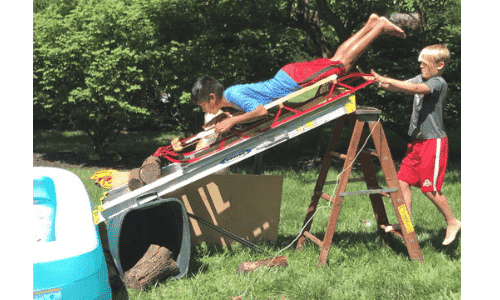How to Use Tech to Teach Responsibility to Tweens

As parents, we can’t teach responsibility to our tweens and teens without technology being part of the equation. Whether it’s teaching responsibility by creating healthy boundaries for technology. Or teaching responsibility in being a good friend and building friendships wisely both online and in person. We’re writing a whole new rulebook for parenting in a digital world. And we need to use tech to teach responsibility to the next generation.
| An interesting resource if you’re debating when to give your child a cell phone is Wait Until 8th. It’s a movement encouraging parents to wait until 8th grade to give kids a smartphone. I’ll freely admit that my kids had phones before they were in 8th, but there is some compelling information on this site. It certainly makes me take the dangers of phones for kids seriously. It reminds me to be consistent and conservative with the tech rules we set as a family. See our post on creating a tech plan that works for your family for more on this. |
My teenage son and I found ourselves the last two people awake in our house a couple weekends ago. He suggested that we watch the The Social Dilemma Netflix documentary because he’d heard other kids talking about it. I didn’t know much about the 2020 documentary, so I confirmed the PG-13 rating and we hit play.
The film showcases interviews with the former executives of a few sites you may have heard of – Google, Facebook, Twitter and Pinterest – and explores the dangerous impact of social media on society. The premise is that the sites were created with good intentions, but have now become ethically questionable as they manipulate what people see and believe and fuel screen addictions to keep making the almighty dollar.
The interview footage alternates with scenes of a fictional family. Scenes like…
- A tween daughter posting selfie after selfie trying to get more likes and then rearranging her hair with tears rolling down her face after someone makes a joke about her ears being too big.
- A teenage son who starts ignoring friends, cutting soccer practice and sneaking as he gets pulled farther and farther into extremist videos online.
- A mom’s attempt to have a phone-free family dinner that ends in a smashed phone screen and an exasperated teen at an empty table.
There was some serious food for thought in this documentary, and my son and I had several good conversations in the days after we watched it. It was actually on my mind quite a bit. Especially after the film talked about my kids’ generation as the first in history to get phones in middle school and research about how emotionally fragile and anxious this generation is shaping up to be.
It pointed out that the rate of kids obtaining drivers’ licenses or experiencing any kind of romantic interaction started dropping while depression and suicide rates began skyrocketing. And there seems to be a correlation to the launch of social media.
I want to teach responsibility and relationship-building and life and social skills to my kids. And like it or not, technology now weaves itself through all of that and gives me another layer to navigate as a parent of Gen Z and Gen Alpha kids. The means that as parents we now get to add to our parenting to-do list to learn and then teach:
- Responsible use of technology
- How to use (and not use) technology to build skills and relationships
Technology can be so fun and so educational. It’s part of so many facets of our life, especially during COVID.
My kids range from third to sixth to ninth grade. Our days are full of Seesaw, Schoology, Zoom, Google Hangouts, Google searches, TikTok, Facebook Messenger, Facetime, Fortnite, Roblox, Minecraft, Rocket League, text messages…my brain hurts just listing those. Oh, and my eyes hurt, too. I better bust out my son’s blue light glasses.

But the dangers of technology, especially for tweens and teens, are no joke. And not always in the ways that we might think.
Here are a couple quotes from The Social Dilemma that just keep rolling around in my brain:
“We’re training and conditioning a whole new generation of people that when we are uncomfortable or lonely or uncertain or afraid we have a digital pacifier for ourselves that is kind of atrophying our own ability to deal with that.”
— Tristan Harris, former design ethicist at Google and co-founder of Centre for Humane Technologies
I would add to this “bored for even a millisecond.” If I don’t make a clear “no-phone on our drive” statement, my son will play games on his phone the entire drive to and from basketball practice instead of talking to me. My husband drives by middle and high school bus stops on his way to work and sees clusters of kids all on their phones – no one interacting with anyone else.
“When we were making the ‘like’ button, our entire motivation was ‘can we spread positivity and love in the world?’ The idea that fast forward to today and teens would be getting depressed when they don’t have enough likes or it could be leading to political polarisation was nowhere on our radar.”
– Justin Rosenstein, former engineer at Facebook and Google, co-founder of Asana
My daughter is only 7, so my sons pretty much make up my experience with tweens and teens on screens so far. I do, however, know what it’s like to be a teenage girl around other teenage girls, and it isn’t always supportive and affirming. Frankly, I’m a little scared of what’s coming, but I’m going to do my best to be prepared.
My intention (and the goal of The Social Dilemma Netflix documentary) isn’t to paint the internet or social media as the villain. But it made me think for the millionth time about the challenge of raising kids in a completely different environment from my own childhood. The extent of my computer use growing up was Oregon Trail in a school computer lab, surviving the screech of the dial-up connecting and crafting the perfect Instant Messenger away message.
Some of what my kids do on screens probably equates to the hours I spent on the phone as a teenager. They’re definitely building relationships by texting and Facetiming friends and playing video games online. But I also worry about how to teach responsibility to my kids in today’s world, and how to help them learn how to find and be good friends, and how to make good choices.
We can’t teach responsibility to our tweens and teens without technology being part of the equation. Whether it’s teaching responsibility by creating healthy boundaries for technology. Or teaching them responsibility in being a good friend and building friendships wisely both online and in person.
Daniel J. Siegel, author of Brainstorm: The Power and Purpose of the Teenage Brain, talks about the transition teens make from looking for support and approval from their families to their friends.

I have to laugh (and nod along) when Siegel says:
“In the wild, without a peer group, an adolescent animal without a peer group is as good as dead.”
Judging by the stench in my son’s room, we’re certainly dealing with animals in the wild, and I vividly remember the feeling as a teen of needing to belong and surround myself with friends. In fact, I missed out on a date I really wanted in high school, and the poor guy later admitted he could never get me alone to ask.
The other thing Siegel says that gives me more heartburn is that teens “can sacrifice morality for membership.” Ouch.
So what can we do as parents?
Appreciate the Importance of Friends for Our Tweens & Teens

Our tweens and teens need and want to be accepted and belong. Having a trusted circle of friends lets them explore their values, roles, identities and ideas. It’s also good for their self-esteem and reduces their risk of anxiety and depression. They can walk through life experiences with friends, and there’s comfort in that. They can talk about how they’re feeling and how things are changing. They can do things together that families can’t or don’t want to do.
Not having trusted friends in middle school can have a negative snowball effect. One study followed sixth graders and found that those without good friendships had no one to stick up for them when they were bullied, leading to a greater sense of threat in seventh grade, and anxiety and depression in the years beyond.
Kids without good friendships in sixth grade (or who lost friendships in the transition to middle school) also showed lower academic engagement in seventh grade and a lower GPA by the end of middle school.
Facebook has watered down the definition of friendship. Facebook is a place where quality trumps quantity. We need to make sure our tweens and teens know that one or a few true friends mean more than thousands of online “friends.”
Moms face their own challenges making and growing friendships because friendships take time. How much? A study of college freshmen shows it takes about 50 hours together to go from acquaintance to casual friend. Another 90 hours to move to actual friend. And 200+ hours to become a close friend. Teens often can’t put that amount of time in without technology.
“We have to put that time in. You can’t snap your fingers and make a friend. Maintaining close relationships is the most important work we do in our lives—most people on their deathbeds agree.”
—Study author Jeffrey Hall
A study published in the journal Child Development followed 169 people, starting at ages 15 and 16. They compared teens with close friendships to teens who were “popular” with larger groups of friends that weren’t as close. Researchers found that people with close friends as teens reported higher levels of self-worth and lower levels of social anxiety and depression at age 25 compared to the “popular” teens with larger but more superficial friend groups.
“As technology makes it increasingly easy to build a social network of superficial friends, focusing time and attention on cultivating close connections with a few individuals should be a priority.”
—Joseph Allen, psychology professor at the University of Virginia and co-author of the study
A lot of these studies build on existing research about loneliness. Research showing that people under 18 and over 65 suffer the most from loneliness. To be clear – loneliness is the feeling you get when you perceive that you’re socially isolated and your needs just aren’t being met by quality relationships. It’s not objective and may not be accurate. It’s about how you feel.
Some people can live relatively solitary lives and not feel lonely, and other people can live a more social life and feel lonely. It would be relatively easy for our teens to rack up a thousand “friends” or followers on social media and still give concerning answers to questions on the UCLA Loneliness Scale like “There are people I can talk to,” and “I feel part of a group of friends.”
Accept that Teenage Friendship Involves Technology

Teens make and grow friendships online and in combination with real life. A Pew Research Center report found that 57% of teenagers ages 13-17 have met a new friend online. Almost 30% of teens say they’ve made more than five friends on social media or in online games.
Though many of these friendships remain online only, teens also stay connected to real-life friends through social media and other online tools. The Pew report showed 70% of teens say social media helps them stay more connected to how their friends are feeling and that 88% of teens text their friends and use other messaging and video apps to stay in touch. And this research is PRE COVID – so I’m guessing these numbers will skyrocket in the next round of research.
Also (be still my ‘90s teenage heart), 85% of teens still call each other on the phone. I love it, but I was still outraged when my teen answered his phone during dinner and proceeded to answer multiple questions about the upcoming science test before admitting “my mom says I have to go.” DURING OUR FAMILY DINNER. My eyes were debating whether to bulge out of my head or roll all the way back to my brain.
Use Technology to Teach Responsibility

Relationships online tend to have the same stumbling blocks as relationships in person. As parents, we can look for opportunities to have important conversations with our kids to teach responsibility and healthy relationship-building.
Things like:
- Appropriate ways to respond to peer pressure
- The fact that being a friend means forgiving from time to time (and saying you’re sorry)
- Trust builds slowly and breaks quickly
- Choosing friends wisely and based on the right things
- Priorities (Is winning the game or losing a friend more important?)
- How and when to stand up for what’s right or hold a friend accountable
- Processing negative emotions like disappointment, frustration or anger (please tell me I’m not the only mom who hears high pitched screams across the house from teens on video games)
- How to reset our perspective when we start comparing ourselves to others
Technology will teach our teens some harder life lessons as well, and we can be there to help. Research shows that:
- 42 percent of teens who use social media have had someone post things about them that they cannot change or control.
- 21 percent report feeling worse about their own life because of what they see from other friends on social media.
- 40 percent of teen social media users feel pressure to post only content that makes them look good to others and get lots of comments or likes.
- 52 percent of all teens have experienced drama among their friends on social media.
- 13-year-olds who checked social media accounts 50-100 times a day were 37% more distressed than those who checked just a few times a day. The number goes up to 47% for kids who check more than 100 times a day.
We can also teach our kids about setting boundaries with technology by establishing phone-free zones and times (ahem, my dinner table) and making sure there’s a time when all technology turns off for the night and comes out of bedrooms for charging in a place parents can monitor.
The American Academy of Pediatrics offers a customizable and printable Family Media Plan. You enter the names and ages of kids and then go through categories like screen-free zones and times, ways to balance online and off-line time, digital citizenship and safety. You can check boxes on provided items or write your own. (A couple of my favorites: not keeping phones under the table at meals under “Manners” and not texting while crossing the street or sharing texts or photos without permission under “Digital Citizenship.”) Then you can print it out to discuss or post in the house.
We can encourage our teens to prioritize time spent in person with friends when possible, and to understand that spending time together online isn’t quite the same. A Pew Research Center study found that even before COVID, only 25% of teens were spending time with friends in person outside of school on a daily basis.
Teach Responsibility By Modeling It

Here are our kids helping us drop off the more than 200 hoodies our SALT effect community donated to Star House for homeless teens over the holidays.
It might feel like our kids only care what their friends think, but they’re still watching and listening to us as parents. They’re looking at how we spend our time, whether we spend time with friends and what those friendships look like.
They also need us to make the time to connect with our kids and actively listen to them – though it may be at sporadic and random times. Maintaining a meaningful connection makes a big difference for your teen’s mental and physical health.
Our tweens and teens need to see us placing value on time spent together without technology:
- playing games
- taking road trips
- reading books
- going outside
- volunteering as a family
- exercising
- doing other shared hobbies
We would love to hear how you’re teaching responsibility to your tweens and teens in a technology-filled world.
Do you have rules that work really well to create healthy boundaries? Have you had important conversations with your kids about their online interactions or habits?
We’re writing a whole new rulebook for parenting in a digital world. It’s going to take plenty of trial and error, but leaning on and learning from one another is a huge help!






